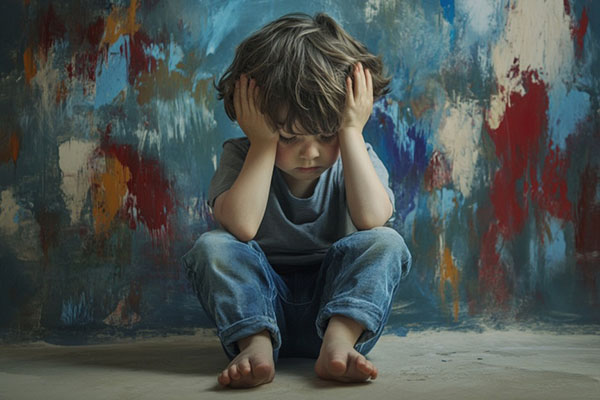MADE IN THE USA | NATURAL, NON-GMO, DAIRY FREE & GLUTEN FREE | FREE SHIPPING IN THE USA
Can stress affect a child’s height? A parent’s personal experience and insights
Understanding the relationship between child stress and development is crucial not only for healthcare providers but also for parents, educators, and policymakers. This article explores the biological and psychosocial mechanisms behind how stress affects children’s height, supported by findings in pediatric endocrinology and child psychology. It also examines long-term outcomes associated with early-life chronic stress and presents actionable strategies for mitigating its effects. Readers will gain insight into how psychosocial stress, hormonal imbalance, and emotional adversity shape physical growth, helping answer the central question: Does stress stunt child growth?
What Is Stress?
Stress in children refers to the body's natural response to emotional or environmental demands, triggered by a perceived stressor such as family conflict or academic pressure. It manifests in two primary forms: acute stress, which is short-term and often caused by specific events (like a test or argument), and chronic stress, which persists over time and can stem from ongoing childhood trauma, unstable home environments, or repeated school stress. Both forms activate the fight-or-flight response, leading to cortisol release—a physiological reaction that, when prolonged, disrupts cognitive development, sleep patterns, and immune function.
Psychologically, children under emotional stress may exhibit anxiety, irritability, or social withdrawal. Physiologically, chronic exposure to environmental stress can impair growth and neural development, especially in early childhood. Triggers range from emotional pressure in kids due to high expectations at school to relational disruptions like family stress and growth issues at home. Coping mechanisms, such as consistent routines, emotional validation, and access to supportive adults, are critical in helping children manage stress healthily. According to the American Psychological Association (2023), over 40% of children aged 8–17 report frequent worries about school performance, indicating a direct link between school stress and health outcomes.
What causes stress in children and teenagers?
Types of stress
Some careless people assume that only adults get stressed, but this is untrue. Children and teenagers, especially those growing up in complicated households, are the victims of severe stress issues.
Scientifically, there are three typical kinds of stress—positive, tolerable, and toxic [1].
-
Positive stress: Children require a small dose of positive stress to grow. Usually, this type of stress occurs briefly when the child enters new environments and experiences, like the first day of school or the first time doing a presentation in front of the class. Some signs of positive stress are racing heartbeats, sweating, and mild shaking. With the understanding and support from adults, kids and teens can effortlessly bounce back and become a braver, more resilient version of themselves.
-
Tolerable stress: When children suffer from the loss of close family members, friends, or pets, they are more likely to have tolerable stress. It will last longer and may develop into childhood trauma if parents neglect the child's emotional needs.
-
Toxic/chronic stress: As the name speaks for itself, toxic stress is the most dangerous kind that inhibits the normal development of individuals. It can damage the neurological system and other internal organs, leaving unrepairable problems in adulthood.

What causes stress?
No matter how well you protect your babies from the harsh world of reality, they are still affected by stress one way or another.
-
Pressure from school and society: School is becoming more demanding than ever. Kids and teens are forced to perform better in class, whether to keep up with their mates or get into excellent universities. Let’s take students in Asian countries like Japan, Korea, and China as examples. They must finish school, attend extra classes, and complete homework from early morning to late night [2]. Without enough sleep, rest, and exercise, it is undoubtedly that their physical and mental health are at higher risk.
-
Family conflicts: Divorce, domestic abuse, and financial hardships are some of the most noticeable stressors that affect the healthy growth of kids and teens. In a broader view, a study by Professor Barry Bogin on children from Guatemala has pointed out that social problems are responsible for stunned height in native kids [3]. Specifically, up to 47% of children under 5 in the Maya communities have significantly shorter stature than their age.
-
Beauty standards: Pre-teens and teens usually experience stress as their bodies change dramatically during puberty. Boys may feel shy due to their short height, whereas girls are more concerned about their weight.
-
Relationships: Whether it is friendships or romantic relationships, kids and teens may have a hard time responding to the needs of others. Moreover, many teenagers feel added stress when discovering their true gender identity and sexual orientation.
Can stress affect a child’s height? A Parent’s Personal Experience and Insights
As stated above, different kinds of stress will leave various consequences in a child’s development—some are short-term, whereas others last until adolescence. Yet, how exactly does stress influence the body? The answer is stress hormones, mainly known as cortisol.
When the kid is in an unfavorable situation, the brain will release cortisol hormones that control mood, motivation, and other organ functions to cope with it. By obtaining a balanced amount of stress hormones, our nervous system is strengthened, making us more productive [4].
On the other hand, when stress goes out of control, it may interrupt the secretion of growth hormones in the pituitary gland [5]. Since our cartilage tissues in the epiphyseal plates require growth hormones to stretch and form new bones, a lack of this chemical can lead to stunned height.
Furthermore, stress can mess up a human's natural sleep-wake cycle and appetite, slowing down the nutrition absorption. Lack of sleep and nutrients is also a vital threat to physical development.
Signs that your child and teens are under stress
Parents need to identify stressors at an early stage to provide timely support. Here are some symptoms according to the World Health Organization:
-
Difficult to concentrate on daily tasks and school work.
-
Constant headaches, body pains, and an upset stomach.
-
Poor sleep quality.
-
Eat less or more than usual.
-
Develop bad habits: drinking, smoking, etc.
-
Have anxiety and depression.
Stress grows on people differently—some have visible signs while others are not. Thus, parents should observe their kids’s behaviors closely and ask for professional help from doctors if necessary.

The Science Behind Stress and Growth Hormones
Chronic stress suppresses growth hormone (GH) secretion by activating the hypothalamic-pituitary-adrenal (HPA) axis, triggering a hormonal cascade that elevates cortisol levels and disrupts normal endocrine function. When the brain perceives stress, the hypothalamus releases corticotropin-releasing hormone (CRH), stimulating the anterior pituitary to produce adrenocorticotropic hormone (ACTH), which in turn prompts the adrenal glands to release cortisol. Elevated cortisol levels interfere with GH synthesis and secretion through both direct and indirect pathways—blunting GH pulses, impairing insulin-like growth factor-1 (IGF-1) activity, and downregulating GH receptor expression. This biological interference underpins why children exposed to chronic psychological or physiological stress often exhibit reduced stature, linking stress endocrine effects to measurable growth delays.
The neurobiological link between cortisol and child height is grounded in data showing that GH suppression can begin within hours of sustained stress exposure. Studies reveal that cortisol inhibits GH-releasing hormone (GHRH) while simultaneously enhancing somatostatin, a GH-inhibitory hormone. This dual mechanism amplifies the hormonal imbalance in kids facing persistent stress, whether from malnutrition, trauma, or environmental instability. Long-term elevation of stress hormones disturbs not just growth but also broader developmental systems, including immune function and metabolism. Understanding this connection between stress and growth hormone regulation is critical for early pediatric intervention strategies targeting hormone imbalance in children.
How parents can help
Parents can follow these tips to lessen stress for their kids:
-
Encourage healthy habits: Instead of letting them play with digital devices for hours, you can accompany them on long walks in the park or join them in a new sport. Regular exercise can produce happy hormones that help mood and keep them fit.
-
Build a balanced diet and add supplements: Parents can try incorporating antioxidant-rich fruit and vegetables or even introduce supplements like NuBest Tall Protein Powder (Chocolate and Vanilla flavor) and NuBest Tall Fizzy Tablets to their daily meals for appetite improvement.
-
Promote adequate sleep: Ensure your toddlers get at least 10 hours and teenagers have around 8-10 hours of sleep every night.
-
Give emotional support: Adults should create an open-minded and welcoming environment so that the child can safely and freely express their will. Plus, parents can listen and give practical advice based on past experiences to help out.
In conclusion,
Chronic stress during childhood can negatively impact height by disrupting hormonal pathways essential to growth, particularly through elevated cortisol levels. Recent studies in pediatric health have shown that prolonged exposure to stressors—ranging from family instability to academic pressure—can interfere with the secretion of growth hormone and impair nutrient absorption. These disruptions often go unnoticed in routine checkups unless physicians employ a multidisciplinary approach that includes emotional health screening and growth tracking. Height insights derived from these assessments underscore the need to integrate stress education and parental awareness into existing public health strategies to mitigate developmental risks.
To promote child well-being and build resilience, awareness programs must move beyond physical checklists to include psychosocial markers. This calls for expanded holistic health policies that involve caregivers, schools, and healthcare providers. By enhancing parental role stress understanding and highlighting the emotional health–height connection, such programs can inform early interventions. Future research should quantify the long-term effects of early-life stress on height and general development, guiding a stress and child development overview that supports policy shifts in public health. The convergence of data-informed practices and emotional support frameworks is critical for sustaining healthy growth trajectories in children.
- Related post: Which Sport is Best for Height Growth?
- - - -
[1] Toxic stress. Center on the Developing Child at Harvard University. (2020, August 17). https://developingchild.harvard.edu/science/key-concepts/toxic-stress/
[2] Kim KI;Won H;Liu X;Liu P;Kitanishi K; (n.d.). Students’ stress in China, Japan and Korea: A Transcultural Study. The International journal of social psychiatry. https://pubmed.ncbi.nlm.nih.gov/9252822/
[3] (PDF) rapid change in height and body proportions of Maya American children. (n.d.-b). https://www.researchgate.net/publication/11063712_Rapid_change_in_height_and_body_proportions_of_Maya_American_children
[4] Higuera, V. (2018, August 14). 4 benefits of stress you didn’t know about. Healthline. https://www.healthline.com/health/benefits-of-stress-you-didnt-know-about
[5] Mousikou, M., Kyriakou, A., & Skordis, N. (2023, March 20). Stress and growth in children and adolescents. Karger Publishers. https://karger.com/hrp/article/96/1/25/842156/Stress-and-Growth-in-Children-and-Adolescents

